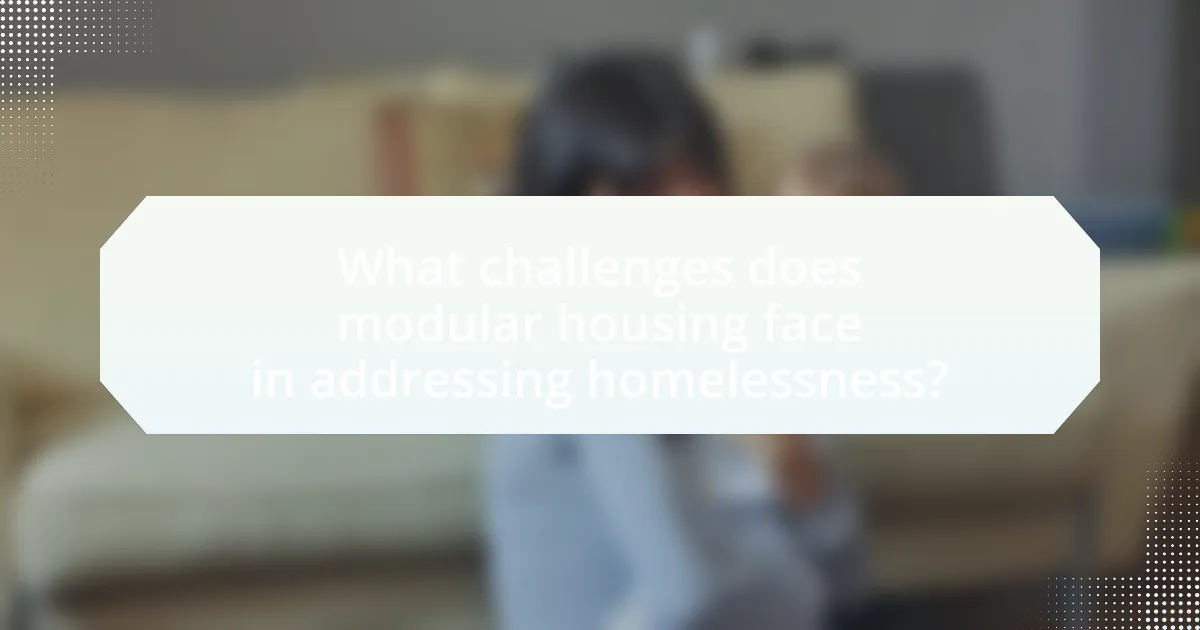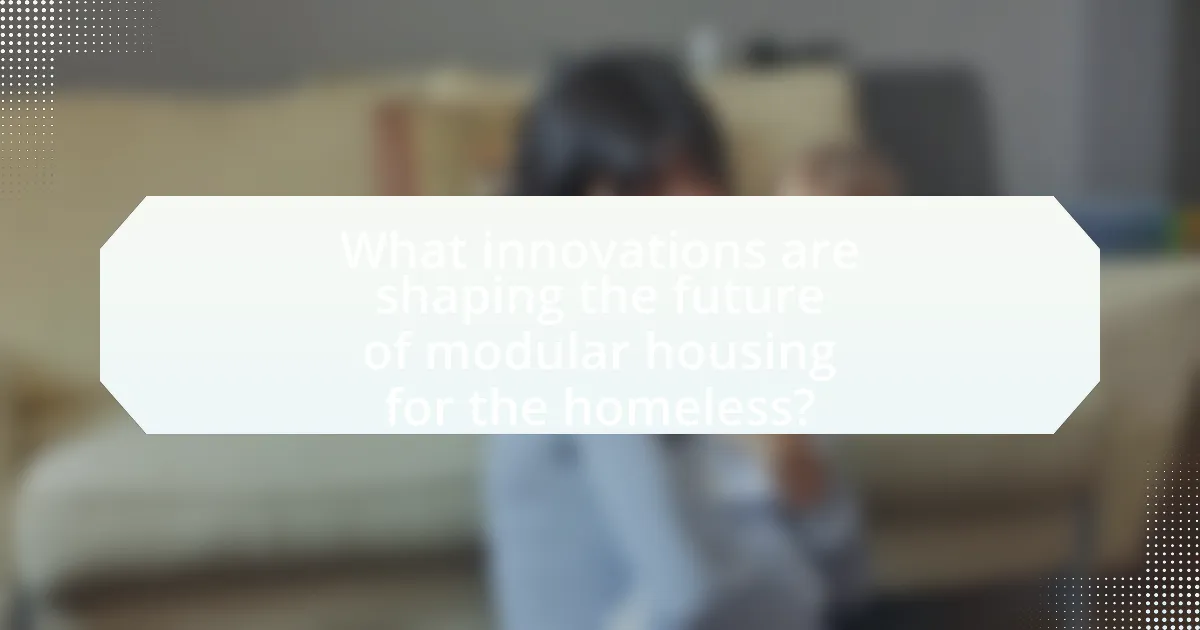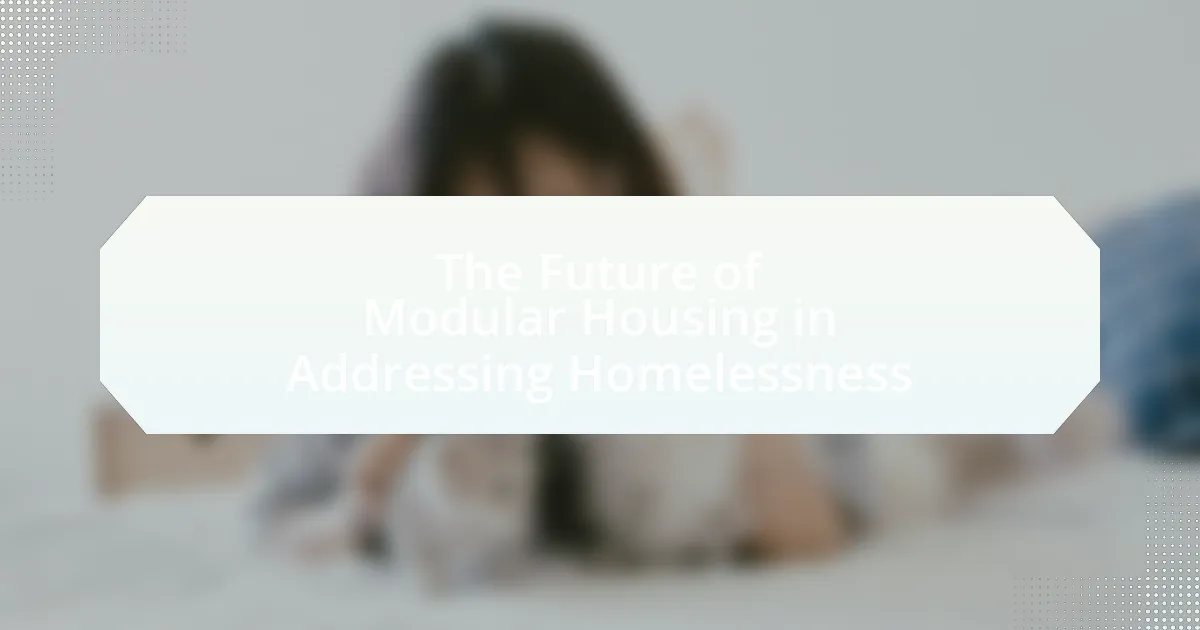Modular housing, characterized by prefabricated structures assembled on-site, presents a promising solution to homelessness by offering affordable and rapidly constructed living options. This article explores the advantages of modular housing, including reduced construction costs and time, as well as its potential to improve living conditions for homeless individuals. It also addresses the challenges faced in implementing modular housing, such as regulatory hurdles and funding limitations, while highlighting successful community-driven projects and best practices for sustainable development. Innovations in technology and materials further enhance the viability of modular housing as a strategic response to the ongoing homelessness crisis.

What is Modular Housing and How Can It Address Homelessness?
Modular housing refers to prefabricated structures built in sections or modules, which are then transported and assembled on-site. This approach can address homelessness by providing affordable, quickly constructed housing solutions. For instance, modular homes can be built in a fraction of the time compared to traditional construction methods, significantly reducing the time it takes to provide shelter for homeless individuals. According to a report by the National Alliance to End Homelessness, modular housing can lower construction costs by 20-30%, making it a viable option for municipalities looking to combat homelessness effectively.
How does modular housing differ from traditional housing solutions?
Modular housing differs from traditional housing solutions primarily in its construction process and speed of assembly. Modular housing is built off-site in factory-controlled environments, allowing for quicker construction times, often reducing the build duration to a matter of weeks compared to several months or years for traditional housing. This method also allows for greater quality control and efficiency, as components are manufactured under consistent conditions. According to the Modular Building Institute, modular construction can reduce waste by up to 90% compared to traditional methods, making it a more sustainable option. Additionally, modular housing can be easily relocated and reconfigured, providing flexibility that traditional housing typically lacks.
What are the key features of modular housing?
Modular housing is characterized by its prefabricated construction, which allows for rapid assembly and flexibility in design. This type of housing typically features standardized components that are manufactured off-site and then transported to the building location for quick assembly, significantly reducing construction time compared to traditional methods. Additionally, modular housing often incorporates sustainable materials and energy-efficient designs, contributing to lower environmental impact. According to the Modular Building Institute, modular construction can reduce waste by up to 90% and energy consumption during the building process by 50%. These features make modular housing a viable solution for addressing homelessness by providing affordable, efficient, and sustainable living options.
Why is modular housing considered a viable solution for homelessness?
Modular housing is considered a viable solution for homelessness due to its cost-effectiveness, speed of construction, and flexibility in design. These structures can be built off-site and assembled quickly, significantly reducing the time needed to provide shelter compared to traditional housing methods. For instance, modular homes can be constructed in a matter of weeks, while conventional homes may take several months or even years. Additionally, the cost of modular housing can be up to 20% lower than traditional construction, making it an economically feasible option for municipalities and organizations addressing homelessness. Studies have shown that cities implementing modular housing solutions have successfully reduced homelessness rates, demonstrating its effectiveness as a practical response to this pressing social issue.
What are the potential benefits of modular housing for homeless individuals?
Modular housing offers several potential benefits for homeless individuals, including affordability, rapid construction, and improved living conditions. The affordability of modular units is significant, as they can be produced at a lower cost compared to traditional housing, making them accessible for low-income populations. Rapid construction is another advantage; modular homes can be built in a fraction of the time, allowing for quicker deployment in response to homelessness crises. Additionally, these homes often provide better living conditions than shelters, offering privacy and stability, which are crucial for mental health and reintegration into society. Studies have shown that stable housing leads to improved health outcomes and reduced reliance on emergency services, further validating the effectiveness of modular housing in addressing homelessness.
How does modular housing improve living conditions for the homeless?
Modular housing improves living conditions for the homeless by providing affordable, quickly constructed, and sustainable living spaces. These units can be built in a fraction of the time compared to traditional housing, allowing for rapid deployment in response to homelessness crises. For instance, modular homes can be assembled in weeks rather than months, significantly reducing the time individuals spend without stable shelter. Additionally, modular housing often incorporates energy-efficient designs, which can lower utility costs for residents, further enhancing their financial stability. Studies have shown that stable housing leads to improved health outcomes and increased access to social services, demonstrating the positive impact of modular housing on the overall well-being of homeless individuals.
What role does modular housing play in providing stability and support?
Modular housing plays a crucial role in providing stability and support by offering quick and cost-effective solutions for housing needs. This type of housing can be constructed rapidly, often within weeks, which allows for immediate shelter for individuals experiencing homelessness. According to a study by the National Alliance to End Homelessness, modular homes can reduce construction costs by up to 20% compared to traditional building methods, making them a financially viable option for municipalities and organizations aiming to address homelessness. Additionally, modular housing often includes supportive services, such as access to healthcare and job training, which further enhances stability for residents.

What challenges does modular housing face in addressing homelessness?
Modular housing faces several challenges in addressing homelessness, primarily related to regulatory hurdles, funding limitations, and community acceptance. Regulatory hurdles include zoning laws and building codes that may not accommodate modular designs, which can delay or prevent project implementation. Funding limitations arise from the need for significant upfront investment, often requiring public-private partnerships that can be difficult to establish. Community acceptance is another challenge, as local residents may oppose modular housing developments due to concerns about aesthetics, property values, or perceived impacts on neighborhood dynamics. These factors collectively hinder the effective deployment of modular housing solutions aimed at alleviating homelessness.
What are the financial barriers to implementing modular housing solutions?
The financial barriers to implementing modular housing solutions include high initial capital costs, limited access to financing, and fluctuating material prices. High initial capital costs arise from the need for significant upfront investment in land, infrastructure, and construction, which can deter developers. Limited access to financing is often due to perceived risks associated with modular construction, leading to challenges in securing loans or investment. Additionally, fluctuating material prices can impact overall project budgets, making it difficult to predict costs accurately and secure funding. These factors collectively hinder the widespread adoption of modular housing as a viable solution for addressing homelessness.
How do funding and investment impact the development of modular housing?
Funding and investment significantly accelerate the development of modular housing by providing the necessary capital for construction, technology, and infrastructure. Increased financial backing allows manufacturers to scale production, reduce costs, and innovate in design and materials, which enhances the overall efficiency of modular housing projects. For instance, a report from the National Association of Home Builders indicates that modular construction can reduce building time by up to 50%, directly linked to adequate funding that supports streamlined processes. Furthermore, investment in modular housing can lead to partnerships with local governments and non-profits, facilitating projects aimed at addressing homelessness, as seen in initiatives like the “Homekey” program in California, which allocated $600 million to convert hotels into modular housing for the homeless. Thus, funding and investment are crucial for advancing modular housing solutions effectively.
What are the costs associated with building and maintaining modular homes?
The costs associated with building and maintaining modular homes typically range from $100 to $200 per square foot for construction, depending on design and materials. This cost is generally lower than traditional homes, which can average between $150 to $300 per square foot. Additionally, ongoing maintenance costs for modular homes can be around 1% of the home’s value annually, covering repairs, utilities, and property taxes. These figures are supported by data from the Modular Building Institute, which indicates that modular construction can reduce overall building costs by 10-20% compared to conventional methods.
How do zoning laws and regulations affect modular housing initiatives?
Zoning laws and regulations significantly impact modular housing initiatives by determining where such structures can be built and under what conditions. These laws often dictate land use, density, and building codes, which can either facilitate or hinder the development of modular housing. For instance, restrictive zoning can limit the placement of modular homes in certain areas, thereby reducing available sites for construction. Additionally, regulations may impose specific design standards that modular homes must meet, potentially increasing costs and complexity. In many urban areas, zoning laws have historically favored traditional housing types, making it challenging for modular housing to gain acceptance. This is evidenced by various studies, such as the 2021 report by the Urban Institute, which highlights that flexible zoning policies can enhance the feasibility of modular housing projects aimed at addressing homelessness.
What are the common regulatory hurdles for modular housing projects?
Common regulatory hurdles for modular housing projects include zoning restrictions, building codes, and permitting processes. Zoning restrictions often limit where modular homes can be placed, as many areas have specific land-use regulations that may not accommodate such structures. Building codes can pose challenges as they may not be updated to reflect the unique aspects of modular construction, leading to compliance issues. Additionally, the permitting process can be lengthy and complex, requiring multiple approvals from various governmental agencies, which can delay project timelines. These hurdles can significantly impact the feasibility and speed of implementing modular housing solutions aimed at addressing homelessness.
How can policy changes facilitate the growth of modular housing?
Policy changes can facilitate the growth of modular housing by streamlining regulations and providing financial incentives. Simplifying zoning laws allows for quicker approvals and reduces bureaucratic delays, which can accelerate the construction of modular units. Additionally, offering tax credits or subsidies for developers can lower costs and encourage investment in modular housing projects. For instance, cities like Los Angeles have implemented policies that promote the use of modular construction to address housing shortages, demonstrating that supportive legislation can lead to increased development and availability of affordable housing options.

What innovations are shaping the future of modular housing for the homeless?
Innovations shaping the future of modular housing for the homeless include advanced construction technologies, sustainable materials, and integrated support services. Advanced construction technologies, such as 3D printing and prefabrication, enable rapid assembly and cost reduction, allowing for quicker deployment of housing solutions. Sustainable materials, like recycled plastics and energy-efficient systems, enhance the environmental impact of these structures while reducing long-term operational costs. Additionally, integrated support services, including mental health resources and job training programs, are increasingly being incorporated into modular housing designs to address the holistic needs of homeless individuals. These innovations collectively aim to provide not only shelter but also pathways to stability and self-sufficiency.
How is technology influencing the design and construction of modular homes?
Technology is significantly influencing the design and construction of modular homes by enhancing efficiency, customization, and sustainability. Advanced software tools enable precise architectural modeling and simulation, allowing for tailored designs that meet specific needs and preferences. Additionally, automation in manufacturing processes reduces construction time and labor costs, with modular components being produced in controlled environments, leading to higher quality and reduced waste. For instance, the use of Building Information Modeling (BIM) facilitates better project management and coordination among stakeholders, resulting in streamlined workflows. Furthermore, the integration of smart home technologies in modular designs promotes energy efficiency and improved living conditions, addressing the needs of vulnerable populations, such as the homeless. These advancements collectively contribute to making modular housing a viable solution for addressing homelessness effectively.
What advancements in materials are being used in modular housing?
Advancements in materials used in modular housing include the adoption of sustainable and high-performance materials such as cross-laminated timber (CLT), structural insulated panels (SIPs), and advanced composites. Cross-laminated timber offers strength and sustainability, reducing carbon footprints compared to traditional materials. Structural insulated panels provide superior insulation and energy efficiency, which is crucial for reducing heating and cooling costs. Advanced composites, often lightweight and durable, enhance the structural integrity and longevity of modular units. These materials not only improve the overall performance of modular housing but also align with environmental goals, making them increasingly popular in addressing housing shortages and homelessness.
How can smart home technology enhance the living experience in modular units?
Smart home technology can significantly enhance the living experience in modular units by providing increased convenience, security, and energy efficiency. For instance, smart thermostats can optimize heating and cooling, leading to reduced energy costs and improved comfort. Additionally, smart security systems, including cameras and door locks, enhance safety for residents, which is crucial in addressing homelessness. According to a study by the National Institute of Standards and Technology, smart home technologies can reduce energy consumption by up to 30%, demonstrating their potential to improve living conditions in modular housing.
What role do community partnerships play in the success of modular housing?
Community partnerships are essential for the success of modular housing as they facilitate collaboration between various stakeholders, including local governments, non-profits, and residents. These partnerships enhance resource sharing, streamline the approval process, and ensure that housing solutions are tailored to meet the specific needs of the community. For instance, a study by the Urban Institute highlights that effective community engagement in modular housing projects leads to increased public support and better integration of housing into existing neighborhoods, ultimately resulting in more sustainable outcomes for addressing homelessness.
How can local governments collaborate with organizations to support modular housing?
Local governments can collaborate with organizations to support modular housing by establishing partnerships that facilitate funding, zoning adjustments, and resource sharing. These collaborations can include public-private partnerships where local governments provide financial incentives or grants to organizations that develop modular housing projects. For instance, cities like Los Angeles have implemented programs that streamline the permitting process for modular housing, thus encouraging organizations to invest in these solutions. Additionally, local governments can work with non-profits and community organizations to identify suitable sites for modular housing and ensure that these developments meet community needs, as seen in various successful initiatives across the United States. This collaborative approach not only accelerates the development of modular housing but also addresses the pressing issue of homelessness effectively.
What examples exist of successful community-driven modular housing projects?
Successful community-driven modular housing projects include the Community First! Village in Austin, Texas, which provides affordable housing for the homeless and emphasizes community engagement. Another example is the modular housing initiative in Vancouver, Canada, where the city partnered with non-profits to create temporary modular homes for the homeless, resulting in over 600 units built in a short timeframe. Additionally, the “Tiny House Project” in Portland, Oregon, showcases a community-led effort to provide tiny modular homes for homeless individuals, fostering a supportive environment. These projects demonstrate effective collaboration between local governments, non-profits, and community members to address homelessness through modular housing solutions.
What best practices should be considered when implementing modular housing solutions?
Best practices for implementing modular housing solutions include ensuring compliance with local building codes, engaging with community stakeholders, and prioritizing sustainability. Compliance with building codes guarantees safety and legality, while community engagement fosters support and addresses local needs. Prioritizing sustainability through energy-efficient designs and materials reduces long-term operational costs and environmental impact. Research indicates that projects adhering to these practices have higher success rates in providing effective housing solutions for homeless populations. For instance, the “Modular Housing for the Homeless” report by the National Alliance to End Homelessness highlights the importance of these practices in successful modular housing initiatives.
How can stakeholders ensure the sustainability of modular housing initiatives?
Stakeholders can ensure the sustainability of modular housing initiatives by implementing comprehensive planning, securing ongoing funding, and fostering community engagement. Comprehensive planning involves assessing local needs and integrating modular housing into broader urban development strategies, which can enhance long-term viability. Securing ongoing funding is crucial; studies show that consistent financial support from government and private sectors can lead to successful project maintenance and expansion. Additionally, fostering community engagement ensures that the needs and preferences of residents are met, which can increase acceptance and support for modular housing solutions. Research indicates that projects with strong community involvement have higher success rates, as seen in initiatives like the Community First! Village in Austin, Texas, which combines modular homes with supportive services to create a sustainable living environment for the homeless.
What strategies can be employed to engage the homeless community in the process?
To engage the homeless community in the process of modular housing development, strategies such as participatory design, outreach programs, and collaboration with local organizations can be employed. Participatory design involves including homeless individuals in the planning and decision-making stages, ensuring their needs and preferences are considered, which has been shown to increase the effectiveness of housing solutions. Outreach programs can facilitate direct communication and relationship-building, allowing for trust and understanding between service providers and the homeless community. Collaborating with local organizations that already have established relationships with the homeless population can enhance engagement efforts, as these organizations can provide valuable insights and facilitate access to the community. Research indicates that when homeless individuals are actively involved in the development process, the resulting housing solutions are more likely to meet their needs and lead to successful outcomes.

Leave a Reply